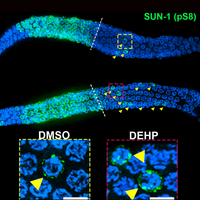Login
SubscribeC. elegans

Epigenetics May Remember Ancestors’ Mutations
Holly Barker, PhD | Dec 1, 2022 | 4 min read
Parents’ mutations, even if they’re not inherited by offspring, could affect subsequent generations through changes to epigenetic marks, a study finds.

Different Genes Influence Lifespan in Male and Female Mice
Natalia Mesa, PhD | Sep 29, 2022 | 3 min read
Researchers say there may be similar, human genes whose effects on lifespan vary by sex.

Worms Live Longer with Mitochondria Powered by Light: Preprint
Alejandra Manjarrez, PhD | May 24, 2022 | 4 min read
Increasing mitochondrial activity in worms by engineering a light-activated proton pump into the organelle’s membrane extends the animals’ lifespan without evidence of health decline, according to a preprint.

Oust the Mouse: A Plan to Reduce Mammal Use in Drug Development
Natalia Mesa, PhD | Mar 15, 2022 | 7 min read
The Scientist spoke to Mount Desert Island Biological Laboratory’s Jim Strickland about the institute’s new MDI Bioscience initiative to perform more drug testing and development in nonmammalian models.

Researchers Use Ultrasound to Control Neurons in Mice
Natalia Mesa, PhD | Feb 9, 2022 | 4 min read
A study shows “sonogenetics” could be a useful new tool in neuroscience and other fields.

Mitochondrial Stress Is Passed Between Generations
Amanda Heidt | Dec 1, 2021 | 3 min read
Researchers identified a novel mechanism by which chemically induced stress is “remembered” by the mitochondria of worms more than 50 generations after the original trigger.

Infographic: How C. elegans Transmit Stress Signals to Offspring
Amanda Heidt | Dec 1, 2021 | 1 min read
Neurons stressed with chemicals produce Wnt, which in turn triggers changes in the germline.

Accurate Protein Production Promotes Longevity
Ruth Williams | Sep 15, 2021 | 3 min read
Worms, flies, and yeast live longer if the fidelity of their protein-making machinery is improved, a study shows.

Can Single Cells Learn?
Catherine Offord | May 1, 2021 | 10+ min read
A controversial idea from the mid-20th century is attracting renewed attention from researchers developing theories for how cognition arises with or without a brain.

Eyeless C. elegans Perceives Colors: Study
Shawna Williams | Mar 4, 2021 | 4 min read
The roundworm uses cues from visible light to help avoid eating toxic bacteria with a distinguishing hue.

Daniel Colón-Ramos Reveals the Mysteries of Worms’ Memories
Claudia Lopez-Lloreda | May 1, 2020 | 3 min read
The Yale neuroscientist seeks to understand the brain’s architecture and function using C. elegans.

Image of the Day: Impaired Meiosis
Amy Schleunes | Feb 7, 2020 | 1 min read
A phthalate commonly found in shampoos, cosmetics, and cleaning products disrupts reproduction in worms.

Switch Master: A Profile of Barbara Meyer
Diana Kwon | Jan 13, 2020 | 9 min read
Working with bacteriophages and nematodes, the University of California, Berkeley, molecular biologist uncovered a role for genetic switches in early development.

How Worms Avoid Eating Bad Bacteria and Warn Their Offspring Too
Jef Akst | Dec 12, 2019 | 3 min read
A small RNA in Pseudomonas triggers an avoidance response in C. elegans that can be passed on to the next generation, according to research presented at this week’s meeting of the American Society for Cell Biology.

Worm Embryogenesis: Cell by Cell and Gene by Gene
Kerry Grens | Dec 1, 2019 | 2 min read
A single-cell map of C. elegans’s transcriptome during development finds cell lineages that start out genetically different and end up as cells of similar function and genetic profile.

Microfluidic Chambers Trigger Sleep in C. elegans
Alejandra Manjarrez, PhD | Nov 19, 2019 | 4 min read
This newly described behavior occurs spontaneously, but can be modulated by food availability, temperature, and the size of the chambers.

How One Neuron Regulates Two Separate Behaviors
Ruth Williams | Nov 14, 2019 | 3 min read
A major sensory neuron in roundworms distinguishes proprioception from harmful touch by sending out local or whole-cell signals, respectively.

C. elegans Healthier Without Longevity Gene
Chia-Yi Hou | Jul 17, 2019 | 2 min read
Worms with the reproduction-related TCER-1 gene deleted could fight off infection for longer and survived better when exposed to heat and radiation.

Biologists Create New Maps of Caenorhabditis elegans Neurons
Chia-Yi Hou | Jul 8, 2019 | 2 min read
The connectomes trace 385 neurons in the male worm and 302 neurons in the hermaphrodite worm.
